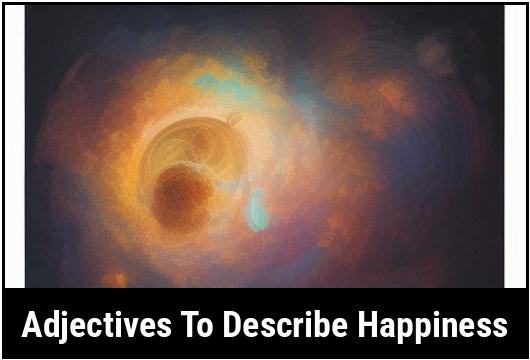- You are here:
- Home »
- adjectives
- » 31 Adjectives To Describe Happiness

31 Adjectives To Describe Happiness
Happiness, the feeling of joy, contentment, and satisfaction, is a fundamental emotion that brings positivity and well-being into our lives. As we strive to express and understand happiness, adjectives play a significant role in enriching our description of this emotion. Adjectives have the power to vividly depict the nuances and shades of happiness, adding depth to our expressions. This article delves into the extensive range of adjectives that can encapsulate the essence of happiness, offering insight into choosing the right adjectives and exploring the various types available.
Key Takeaways
- Adjectives play a crucial role in expressing the multifaceted nature of happiness.
- Choosing the right adjective is essential to accurately convey the nuances of one’s happiness.
- Various types of adjectives can be used to describe happiness, ranging from simple and direct to nuanced and elaborate.
Adjectives To Describe Happiness
1. Delightful
Imagine a magical moment that fills your heart with pure joy and leaves you with a broad smile on your face. That’s the feeling of delightful happiness. It encompasses those small, precious instances that illuminate our lives and make them worth living.
2. Blissful
When happiness consumes us completely, bathing our souls in a sense of peace and overwhelming euphoria, we can describe it as blissful. It is a serene and tranquil state of mind where worries and sorrows no longer exist.
3. Exuberant
Exuberant happiness is like a bubbling fountain that cannot be contained. It overflows with infectious energy and enthusiasm, making us feel alive and full of life. It’s that exhilarating feeling that prompts us to dance, sing, and embrace the world around us.
4. Ecstatic
When happiness reaches an intense peak, it becomes ecstatic. It is a state of euphoria where an overwhelming surge of indescribable joy floods our senses, leaving us breathless and on cloud nine.
5. Radiant
Radiant happiness is like a warm and glowing sunbeam that radiates from within. It lights up our lives and those around us, spreading positivity and goodwill wherever it goes. It is a state of being that can light up the darkest days.
6. Jubilant
Jubilant happiness is synonymous with immense satisfaction and triumph. It is a feeling of great delight and exultation that arises from achieving a long-awaited goal, receiving good news, or experiencing a moment of pure victory.
7. Serene
Happiness can also be quiet and calm, like a serene lake shimmering under the moonlight. Serene happiness is a state of inner peace and tranquility that comes from embracing the present moment, finding contentment in simplicity, and appreciating the beauty of life in its most peaceful form.
8. Content
Contentment is a deep-seated form of happiness that arises when we are grateful for what we have and find fulfillment in the simple joys of life. It is a state of balance and acceptance, allowing us to savor and appreciate the present without yearning for more.
9. Grateful
Grateful happiness stems from a profound appreciation for the blessings in our lives. It is a feeling that arises when we recognize and acknowledge the abundance of goodness that surrounds us. Being grateful for what we have brings a deep and lasting joy.
10. Whimsical
Happiness can also have a whimsical and playful nature, like a child lost in a world of imagination and wonder. Whimsical happiness is light-hearted, free-spirited, and filled with spontaneous joy that brings out our inner child.
11. Fulfilling
When our actions align with our purpose and we experience a deep sense of achievement, happiness becomes fulfilling. It is a state of contentment that arises from pursuing our passions, living authentically, and making meaningful contributions to the world.
12. Elated
Elated happiness is that feeling of overwhelming excitement and exhilaration we experience when something incredible happens. It is a surge of energy and joy that leaves us feeling ecstatic, amazed, and awe-inspired.
13. Vibrant
Vibrant happiness is like a vivid explosion of colors that brightens up our lives. It is a dynamic and energetic state of being that fills us with vitality, enthusiasm, and a zest for life. Vibrant happiness energizes us and makes us feel alive.
14. Optimistic
Optimistic happiness is the belief that everything will ultimately work out for the best, despite temporary setbacks. It is the ability to see the silver lining in every situation, embrace hope, and find joy in anticipating a brighter future.
15. Euphoric
Euphoric happiness is a feeling of intense delight and complete euphoria that envelops us. It is a state of pure bliss where all worries and troubles dissolve into nothingness, allowing us to revel in unbridled joy and elation.
16. Lighthearted
Lighthearted happiness is when we can let go of our burdens and worries, experiencing a sense of lightness and carefreeness. It is a feeling of unburdened joy that allows us to laugh, play, and enjoy the simple pleasures of life without inhibition.
17. Invigorated
Invigorated happiness is born from a burst of energy and renewed enthusiasm. It is a feeling that arises after an inspirational experience, a moment of revelation, or simply spending time in nature. It uplifts our spirits and revitalizes our zest for life.
18. Harmonious
Happiness can also be described as harmonious when everything aligns perfectly. It is a state where our inner and outer worlds are in sync, peace pervades our being, and a sense of balance and contentment prevails.
19. Enthusiastic
Enthusiastic happiness is a feeling of genuine excitement and passion for life. It is when we approach each day with a zestful attitude, embracing opportunities, and radiating positive energy. Enthusiasm infuses our lives with joy and encourages us to seize the day.
20. Radiating
Radiating happiness is like an overflowing fountain of joy that cannot be contained. It is a state of being where our happiness shines so brightly that it is visible to others, inspiring and uplifting those around us.
21. Wholesome
Wholesome happiness is a state of well-rounded contentment and fulfillment. It encompasses all aspects of our life, including physical, emotional, and spiritual well-being. It is a holistic and sustainable form of happiness that nourishes our entire being.
22. Satisfied
Satisfied happiness is born from a sense of accomplishment and fulfillment. It is when we feel content and gratified knowing we have achieved our goals, fulfilled our responsibilities, or made a positive impact. Satisfaction brings a deep sense of joy and peace.
23. Hopeful
Hopeful happiness is the belief in the potential for a brighter future and the anticipation of positive things to come. It is a feeling that generates optimism, resilience, and joy, even in challenging times. Hopeful happiness keeps our spirits high.
24. Uplifting
Uplifting happiness is that contagious joy which spreads like wildfire. It is when we are in the company of others who radiate positivity and bring out the best in us. Uplifting happiness inspires and motivates, creating a ripple effect of joy.
25. Tranquil
Tranquil happiness is a state of inner peace and serenity. It is when we find solace in quiet moments and experience a deep sense of calmness and stillness. Tranquil happiness allows us to connect with our inner selves and find contentment in solitude.
26. Fulfilled
Fulfilled happiness comes from living a life aligned with our values and purpose. It is when we are true to ourselves, pursue our passions, and make a difference in the lives of others. Fulfilled happiness brings a profound sense of joy and satisfaction.
27. Infectious
Infectious happiness is that contagious joy that spreads effortlessly from one person to another. It is when our own happiness has the power to light up the lives of those around us, creating a ripple effect of positivity, laughter, and smiles.
28. Enlivening
Enlivening happiness is when we experience a surge of energy and vitality that revitalizes our very being. It is a state of vibrant aliveness and enthusiasm that fills us with a renewed zest for life. Enlivening happiness invigorates our body, mind, and soul.
29. Bountiful
Bountiful happiness is a feeling of abundant joy and gratitude. It is when we recognize the countless blessings, big and small, that enrich our lives. Bountiful happiness allows us to appreciate the richness and beauty that surrounds us each day.
30. Empowering
Empowering happiness comes from a deep sense of self-fulfillment and personal growth. It is a feeling of strength, confidence, and self-assurance that arises from overcoming challenges, pushing our limits, and achieving personal milestones. Empowering happiness empowers us to strive for greater heights.
31. Timeless
Timeless happiness transcends the boundaries of time and space. It is a feeling that fills our hearts and souls with eternal joy and contentment. Timeless happiness allows us to cherish precious moments, memories, and connections that stay with us forever.
Why Use Adjectives To Describe Happiness
Adjectives serve as the palette with which we paint the picture of happiness. They add texture, color, and depth to our descriptions, allowing for a more nuanced and evocative portrayal of this emotion. While "happy" and "joyful" are commonly used to convey happiness, employing a wide array of adjectives enables us to capture the subtle variations and intensities of happiness. This enriches our communication, helping others to better understand and connect with our experiences of happiness. Moreover, using diverse adjectives fosters creativity and eloquence in our expressions, amplifying the impact of our communication.
How To Choose The Right Adjective To Describe Happiness
Selecting the appropriate adjective to describe happiness involves considering the specific nuances and shades of the emotion being experienced. The chosen adjective should accurately depict the intensity, quality, and context of the happiness, ensuring that the description resonates with the intended audience. It is essential to be mindful of the connotations and implications of each adjective, as different words can evoke distinct emotional and sensory associations. In addition, the selected adjective should align with the overall tone and style of the communication, whether it be formal, informal, poetic, or conversational.
Types Of Adjectives For Describing Happiness
Simple And Direct Adjectives
"Simple" and "direct" adjectives provide straightforward descriptions of happiness, expressing the basic state of being happy without intricate nuances. Examples include:
- Euphoric: A state of intense happiness and excitement.
- Cheerful: Brimming with happiness and optimism.
- Blissful: Serene and joyful, experiencing complete happiness.
- Ecstatic: Overwhelming, intense happiness and delight.
Nuanced And Evocative Adjectives
Nuanced adjectives offer deeper and more intricate descriptions of happiness, often capturing specific qualities or contextual intricacies. Examples include:
- Exuberant: Radiating unrestrained joy and energy.
- Sanguine: Marked by cheerfulness and a positive outlook.
- Elated: Thrilled and overjoyed, experiencing profound happiness.
- Jubilant: Expressing triumph, joy, and exuberance.
Subtle And Reflective Adjectives
Subtle adjectives delicately convey the quieter, introspective facets of happiness, often associated with contentment and inner peace. Examples include:
- Serene: Calm, peaceful, and contented.
- Tranquil: Experiencing a deep sense of peaceful happiness.
- Content: Satisfied and at ease, feeling a quiet happiness.
- Fulfilled: Experiencing a sense of completion and satisfaction.
Poetic And Expressive Adjectives
These adjectives are highly evocative and vivid, often used in literary and expressive contexts to beautifully capture the essence of happiness. Examples include:
- Ethereal: Embodying a delicate, otherworldly joy and beauty.
- Radiant: Gleaming with happiness, exuding warmth and brilliance.
- Effervescent: Buoyant and bubbly happiness, full of life and energy.
- Resplendent: Dazzling and magnificent, brimming with happiness and splendor.
Complex And Layered Adjectives
Complex adjectives offer rich and multi-layered descriptions of happiness, blending various emotional elements and experiences. Examples include:
- Euphoric: A complex and intense happiness, bordering on ecstasy.
- Transcendent: A profound, elevated state of happiness and fulfillment.
- Rapturous: Overwhelmed with ecstatic joy and bliss, reaching sublime happiness.
- Exultant: Marked by triumphant joy and exuberance, often in celebration of achievement.
In the realm of happiness, adjectives serve as the vivid colors on the palette of expression, allowing us to paint rich and evocative portraits of our emotional experiences. From simple and direct adjectives to complex and layered ones, the plethora of adjectives available empowers us to capture the multifaceted nature of happiness. Delving into the nuances of adjectives and their application in describing happiness not only enhances our eloquence and creativity in communication, but also deepens our understanding and appreciation of this profound emotion. By embracing the diverse spectrum of adjectives to describe happiness, we invite others to share in the vibrancy of our experiences and forge deeper connections through the art of expression.
Examples Of Adjectives For Different Types Of Happiness
Happiness is an emotion that is universally desired and sought after by individuals around the world. It is a state of well-being and contentment that brings joy, pleasure, and harmony. When attempting to describe happiness, one often turns to adjectives to convey the intensity and nature of the experience. Adjectives serve as powerful tools in painting a vivid picture of happiness, allowing us to communicate our feelings effectively.
1. Simple Happiness
Simple happiness refers to the joy and contentment derived from the everyday moments and simple pleasures in life. It is often characterized by a sense of ease and tranquility. Here are some adjectives that can be used to describe simple happiness:
- Serene: A serene happiness is calm and peaceful, devoid of worries or stress. It is like being in a state of blissful tranquility.
- Content: Contented happiness reflects a deep satisfaction and acceptance of one’s current state. It is a feeling of being at peace with oneself and the surrounding world.
- Satisfied: A satisfied happiness signifies a sense of fulfillment and gratification, often from meeting one’s needs or desires.
Example sentences:
- "As she sat by the fireplace, sipping hot cocoa, she felt a serene happiness wash over her."
- "After completing a day’s work in the garden, he surveyed his handiwork with a content smile on his face."
- "She had worked tirelessly on the project, and finally, she felt a deep sense of satisfied happiness upon its completion."
2. Ecstatic Happiness
Ecstatic happiness is an intense and overwhelming emotion, often associated with moments of great joy or excitement. It is a state of euphoria that brings an indescribable sense of delight. Here are some adjectives to describe ecstatic happiness:
- Blissful: Blissful happiness is a state of utter joy and happiness, where one’s heart feels light and full of positive energy.
- Radiant: Radiant happiness is vibrant and exudes joy in a way that brightens not only the person experiencing it but also those around them.
- Rapturous: Rapturous happiness is characterized by extreme pleasure and enthusiasm, as if one is in a state of pure ecstasy.
Example sentences:
- "As the music swelled during the concert, she felt a blissful happiness envelop her, causing tears of joy to stream down her face."
- "After receiving the news of her promotion, she walked into the office with a radiant happiness that brought smiles to everyone she encountered."
- "When he saw her waiting for him at the airport after months of separation, he rushed into her arms with a rapturous happiness that words could not capture."
3. Nostalgic Happiness
Nostalgic happiness is often associated with fond memories and a deep longing for past moments of joy. It is a bittersweet sensation that evokes a mixture of happiness and a tinge of sadness. Here are some adjectives that can be used to describe nostalgic happiness:
- Wistful: Wistful happiness is tinged with a hint of sadness, as one reminisces about the past and longs for moments that have passed.
- Melancholy: Melancholy happiness conveys a sense of sorrowful joy, often arising from a poignant memory or a sense of longing for the past.
- Sentimental: Sentimental happiness is marked by a deep emotional attachment to memories or objects, evoking a sense of nostalgia.
Example sentences:
- "As she looked through old photographs of her childhood, she couldn’t help but feel a wistful happiness wash over her, remembering the innocence of those days."
- "Walking through the park, he stumbled upon the tree where he used to spend hours reading as a child, filling him with bittersweet melancholy happiness."
- "As she held her grandmother’s necklace in her hands, she couldn’t help but feel a sentimental happiness, remembering all the love and joy it represented."
4. Empathetic Happiness
Empathetic happiness refers to the joy and happiness experienced by witnessing or sharing in someone else’s happiness. It is a selfless form of happiness that arises from our ability to connect with others. Here are some adjectives that can be used to describe empathetic happiness:
- Delighted: Delighted happiness is the feeling of immense pleasure that comes from seeing someone else experience joy or achieving something significant.
- Sincere: Sincere happiness reflects an honest and authentic sense of happiness, where one genuinely shares in the joy of others.
- Warmhearted: Warmhearted happiness describes the compassionate and caring nature of happiness that arises from being genuinely happy for someone else.
Example sentences:
- "As she watched her child take their first steps, she felt a delighted happiness well up within her, proud of their achievement."
- "He congratulated his friend with a sincere happiness, genuinely happy for their success."
- "She greeted her sister’s wedding announcement with warmhearted happiness, excited for her sister’s new chapter in life."
Common Mistakes In Using Adjectives To Describe Happiness
When using adjectives to describe happiness, it is essential to use them correctly and accurately convey our feelings. Here are some common mistakes that people make and how to avoid them:
-
Using vague or generic adjectives: Avoid using adjectives that are too generic or vague, as they do not effectively convey the specific type of happiness you are experiencing. Instead, opt for more precise and descriptive adjectives that accurately capture the nuances of your emotions.
-
Overusing superlatives: While superlatives can add emphasis to your description, it is essential to use them sparingly. Overusing superlatives can dilute their impact and make your writing appear exaggerated or insincere. Choose your superlatives wisely and use them when they are truly warranted.
-
Neglecting context: Consider the context in which you are using the adjectives. The same adjective may have different connotations depending on the situation. Take into account the events, people, or situations that contribute to your happiness and choose adjectives that align with the overall context.
-
Failing to use a variety of adjectives: Using the same adjectives repeatedly can make your writing repetitive and monotonous. Experiment with different adjectives to describe various facets of happiness and create a more engaging and dynamic description.
Using Adjectives Effectively
To use adjectives effectively when describing happiness, consider the following tips:
-
Select adjectives that capture the specific emotion: Choose adjectives that accurately reflect the particular type of happiness you are experiencing. Consider the intensity, nature, and nuances of your emotions and select adjectives that can effectively convey them.
-
Use similes and metaphors: Similes and metaphors can enhance the clarity and vividness of your description. By comparing your happiness to something else, you can create a stronger and more relatable image in the reader’s mind.
-
Provide examples or anecdotes: To provide more depth and context to your description, include specific examples or anecdotes that illustrate the happiness you are experiencing. This can help the reader connect with your emotions and bring your description to life.
-
Vary sentence structure and length: Experiment with different sentence structures and lengths to make your writing more dynamic and engaging. Mix shorter, punchy sentences with longer, more descriptive ones to create a balanced and captivating rhythm.
-
Revise and edit: As with any form of writing, it is essential to revise and edit your work. Read through your description of happiness carefully, ensuring that the adjectives you have chosen accurately convey your emotions. Eliminate any unnecessary or repetitive words to make your writing more concise and impactful.
Exercises And Practice
To further develop your skills in using adjectives to describe happiness, here are some exercises and practice prompts:
-
Describe a moment of simple happiness in your life using at least three adjectives. Write a short paragraph that paints a vivid picture of this experience.
-
Choose one adjectives to describe each of the following scenarios: a wedding ceremony, the birth of a child, and a surprise party. Write a sentence or two explaining your choice and how it reflects the specific type of happiness in each situation.
-
Read a piece of literature or watch a film that depicts a character experiencing happiness. Write a short analysis of how the author or director uses adjectives and other literary techniques to describe and convey this happiness.
-
Write a descriptive poem or song lyrics that captures the essence of ecstatic happiness. Experiment with various adjectives, similes, and metaphors to create a powerful and evocative portrayal of this intense emotion.
Conclusion
Adjectives play a crucial role in describing happiness, allowing us to effectively communicate our emotions and experiences. From simple and serene happiness to intense and rapturous joy, there is a vast array of adjectives that can capture the various shades and nuances of this complex emotion.
By selecting the right adjectives, using them effectively, and avoiding common mistakes, we can create descriptions of happiness that are vivid, relatable, and engaging. So, let us celebrate happiness by embracing the power of adjectives to convey its beauty and essence.
FAQS On Adjectives To Describe Happiness
What Are Some Common Adjectives Used To Describe Happiness?
Some commonly used adjectives to describe happiness include joyful, elated, content, euphoric, and blissful.
Can You Provide Examples Of Adjectives That Convey A Deeper Level Of Happiness?
Yes, some examples of adjectives that convey a deeper level of happiness include radiant, ecstatic, exuberant, fulfilled, and jubilant.
Are There Any Adjectives That Specifically Describe A Peaceful Or Tranquil Kind Of Happiness?
Indeed, there are several adjectives that capture the feeling of peaceful or tranquil happiness, such as serene, calm, tranquil, peaceful, and harmonious.
How Do Positive Emotions Contribute To Happiness?
Positive emotions play a vital role in happiness by increasing feelings of well-being and satisfaction. Adjectives like cheerful, optimistic, content, and grateful are often associated with positive emotions and contribute to an overall sense of happiness.
Are There Any Adjectives That Describe A Temporary Or Fleeting Happiness?
Yes, there are adjectives that describe a temporary or fleeting happiness, such as fleeting, momentary, short-lived, and ephemeral. These adjectives suggest a happiness that is, at best, temporary and may not last long.








